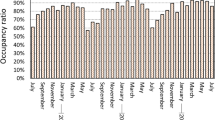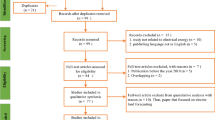Abstract
Economic inefficiency can be caused by time-invariant retail electricity prices because they do not reflect variations in the cost of providing electricity during the day. Time-of-use (TOU) pricing—higher electricity prices during peak hours and lower electricity prices during off-peak hours—is by far the most common way to achieve more efficient levels of electricity consumption through reducing peak demand. The empirical evidence of the effectiveness of TOU pricing is sparse in the commercial and industrial sectors and there is no consensus in the literature on the statistical significance and magnitude of the effects. Applying a quasi-experimental design, this study evaluates an ongoing experiment of voluntary business TOU pricing plan by a major utility company in the Phoenix metropolitan area. Using the nearest-neighbor matching method, we identify control customers for the voluntary participants of the business TOU pricing. From difference-in-differences analysis, we find a statistically significant reduction in peak-hour electricity demand in response to the TOU pricing. We also find that there is no conservation effect, meaning that the total level of electricity consumption does not change under the TOU pricing.




Similar content being viewed by others
Notes
None of the TOU participants in our study was large enough to fall into the fourth tier marginal price.
At SRP, a TOU price plan is mandatory for any customer exceeding 300,000 kWh per month for three consecutive months. In this paper, no customer falls into this category.
This is a natural assumption in our study given that one example of usage of electricity is for the proper functioning of the AC, which generates a comfortable working environment for the businesses in question to provide their services (i.e. produce their output). For any given outside temperature, the marginal electricity needed for lowering the inside temperature by one degree increases as the inside temperature lowers, which is equivalent to the statement that electricity exhibits strictly diminishing marginal productivity. This assumption also ensures strict concavity of the firm’s maximization problem and hence ensures an interior solution in terms of optimal demand, which is also realistic.
The mathematical proof is also straightforward. First order conditions of the firm’s maximization problem ensure that marginal product equals to the input price (upon normalizing the price of output to unity). Consequently, when the relative price of peak electricity increases (as it does under TOU pricing), the strict diminishing productivity assumption ensures the drop in optimal demand for peak electricity.
Despite the strong evidence included in this paper regarding the conditional independence of the treatment to certain unobservables, because those who switched to TOU are volunteers instead of being randomly assigned, the non-existence of selection bias cannot be proved theoretically. This remains a limitation of the current study.
Starting in August 2012, we emailed 8500 standard business non-TOU customers on an SRP email distribution list about an opportunity to participate in the TOU plan. Interested customers then contacted SRP to switch to TOU plan. Unlike Phase I, interested customers in Phase II could immediately switch to TOU plan after they were recruited, so the potential “pre-action” problem was avoided. We also immediately activated their interval data collection when the customers switched to TOU plan. The treatment group customers in the second phase study switched to TOU plan from November 2012 to June 2013, with most of them switching during April-June 2013. In June, we identified a control customer for each treatment group customer and we then activated the interval data collection for these control customers in June. NAICS code, summer electricity usage and monthly maximum demand for May–October 2012 were used to identify a comparable control group. One drawback of the second phase study is that we were not able to collect the “pre-test” interval demand data. This is because the 15-min interval data collection needs to be activated after we identify the customers to be in the study. Thus we cannot conduct a DID analysis using the 15-min demand data.
To further justify that the control and treatment group customers have similar load profiles prior to the treatment, we perform the balance checks using hourly electricity usage (“Appendix 2”) and the results confirm the credibility of our empirical approach.
Since the standard price rate is a decreasing block rate based on usage levels, the average price level of a standard price rate customer will be endogenously determined with usage levels. However this does not impact the price ratio in the fixed effects model so it would not impact the estimation of price elasticity of substitution. As a result, we do not include price level as a control variable in the fixed effects model.
We convert the actual 15-min demand into normalized 15-min demand, where the sum of the normalized demand for a day equals 1. Looking at normalized demand profiles enables us to compare relative demand independent of usage level, since usage level is different for every business customer.
For all the standard rate business customers in July 2014, the total average demand during the system peak hours (4–7 pm) is 762MW. Based on the results from Table 3, TOU rate can lead to a 0.2–0.5% decrease in peak-hour demand. This is equivalent to have a 2.7 MW average reduction during 4–7 pm.
The bill saving is calculated using similar DID methods: \({ Bill Saving} = { (BT post} - { BT pre )} - { (BC post} - { BC pre)}\), where BT post is the average summer electricity bill of the treatment customer after switching to the TOU plan; BT pre is the average summer electricity bill of the treatment customer before switching to the TOU plan; BC post is the average summer electricity bill of the control customer after the treatment group switched to the TOU plan; BC pre is the average summer electricity bill of the control customer before the treatment group switched to the TOU plan.
References
Acton JP, Park RE (1987) Response to time-of-day electricity rates by large business customers: reconciling conflicting evidence. Rand, R-3477-NSF
Aigner D, Hirschberg J (1985) Commercial/industrial customer response to time-of-use electricity prices: some experimental results. RAND J Econ 16(3):341–355
Aigner D, Newman J, Tishler A (1994) The response of small and medium-size business customers to time-of-use (TOU) electricity rates in Israel. J Appl Econom 9(3):283–304
Borenstein S, Holland S (2005) On the efficiency of competitive electricity markets with time-invariant retail prices. Rand J Econ 36(3):469–493
Brown JD, Earle JS (2013) Do SBA loans create jobs? IZA Discussion Paper No. 7544. http://ftp.iza.org/dp7544.pdf
Campbell DT, Stanley C (1963) Experimental and quasi-experimental designs for research. Houghton Mifflin, Boston
EPRI (2010) Guidelines for designing effective energy information feedback pilots: Research protocols. Electric Power Research Institute, Report # 1020855
Faruqui A, Sergici S (2009) Household response to dynamic pricing of electricity—A survey of the experimental evidence. Working paper. http://www.hks.harvard.edu/hepg/Papers/2009/The%20Power%20of%20Experimentation%20_01-11-09_.pdf
Faruqui A, Sergici S, Akaba L (2014) The impact of dynamic pricing on residential and small commercial and industrial usage: new experimental evidence from connecticut. Energy J 35(1):137–159
Faruqui A, Sergici S, Lessem N, Mountain D (2015) Impact measurement of tariff changes when experimentation is not an option—a case study of Ontario, Canada. Energy Econ 52:39–48
Hartway R, Price S, Woo CK (1999) Smart meter, customer choice and profitable time-of-use rate option. Energy 24(10):895–903
Hirschberg JG, Aigner DJ (1983) An analysis of commercial and industrial customer response to time-of-use rates. Energy J 4:103–126
Ho DE, Imai K, King G, Stuart EA (2007) Matching as nonparametric preprocessing for reducing model dependence in parametric casual inference. Polit Anal 15:199–236
Jessoe K, Rapson D (2014) Commercial and industrial demand response under mandatory time-of-use electricity pricing. J Ind Econ (Accepted)
Kirkeide L (2012) Effects of three-hour on-peak time-of-use plan on residential demand during hot Phoenix summers. Electr J 25(4):48–62
Linden A, Samuels S (2013) Using balance statistics to determine the optimal number of controls in matching studies. J Eval Clin Pract 19:968–975
Newsham GR, Bowker BG (2010) The effect of utility time-varying pricing and load control strategies on residential summer peak electricity use: a review. Energy Policy 38(7):3289–3296
Normand SLT, Landrum MB, Guadagnoli E, Ayanian JZ, Ryan TJ, Cleary PD, McNeil BJ (2001) Validating recommendations for coronary angiography following an acute myocardial infarction in the elderly: a matched analysis using propensity scores. J Clin Epidemiol 54:387–398
Park RE, Acton JP (1984) Large business customer response to time-of-day electricity rates. J Econom 26:229–252
Parrish D (2013) Time of use tariffs: examples from the U.S. Presentation at the ERRA Tarff/Pricing Committee, Abu Dhabi, U.A.E. 6-7 February 2013. http://www.naruc.org/international/Documents/parrish%20time%20of%20use%20rates%20abu%20dhabi.pdf
Rosenbaum PR, Rubin DB (1983) The central role of the propensity score in observational studies for causal effects. Biometrika 70(1):41–55
Rubin DB (2001) Using propensity scores to help design observational studies: application to the tobacco litigation. Health Serv Outcomes Res Methodol 2:169–188
Tishler A (1983) The industrial and commercial demand for electricity under time-of-use pricing. J Econom 23:369–384
Tishler A (1984) A model of industrial demand for electricity under time-of-use pricing and three labor shifts. Resour Energy 6:107–127
Williamson O (1966) Peak-load pricing and optimal capacity under indivisibility constraints. Am Econ Rev 56(4):810–827
Woo CK (1985) Demand for electricity of small nonresidential customers under time-of-use (TOU) pricing. Energy J 6:115–127
Acknowledgements
We would like to thank the following individuals for the helpful comments they offered during the preparation of this paper: Aaron Dock, Kerry Smith, Michael Hanemann, Nicolai Kuminoff, Kelly Bishop, Alvin Murphy, Daniel Laney, Ryan Fulleman, Melissa Buchler and the two anonymous reviewers. Funding for this research was provided by the National Science Foundation under Grant No. 1509077 and Salt River Project CREC research grant.
Author information
Authors and Affiliations
Corresponding author
Appendices
Appendix 1: Industry Analysis
Business customers’ response to TOU pricing could differ by industry type. Thus we create dummy variables indicating different industry types and add interaction terms of the industry dummies with price ratio variables. The industry categories found in Phase I and the definitions of the industry dummies used in the econometric models are shown in Table 8. Table 9 lists the results of industry analysis. The base case is the manufacturing sector. The coefficients for the interaction terms are positive indicating that manufacturing sector has greater response to TOU than the rest sectors.
Appendix 2: Balance Checks Using Hourly Electricity Use
See Table 10.
Rights and permissions
About this article
Cite this article
Qiu, Y., Kirkeide, L. & Wang, Y.D. Effects of Voluntary Time-of-Use Pricing on Summer Electricity Usage of Business Customers. Environ Resource Econ 69, 417–440 (2018). https://doi.org/10.1007/s10640-016-0084-5
Accepted:
Published:
Issue Date:
DOI: https://doi.org/10.1007/s10640-016-0084-5




